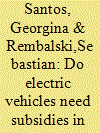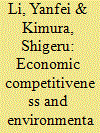|
|
|
Sort Order |
|
|
|
Items / Page
|
|
|
|
|
|
|
| Srl | Item |
| 1 |
ID:
109617


|
|
|
|
|
| Publication |
2011.
|
| Summary/Abstract |
The battery size of a Plug-in Hybrid Electric Vehicle (PHEV) is decisive for the electrical range of the vehicle and crucial for the cost-effectiveness of this particular vehicle concept. Based on the energy consumption of a conventional reference car and a PHEV, we introduce a comprehensive total cost of ownership model for the average car user in Germany for both vehicle types. The model takes into account the purchase price, fixed annual costs and variable operating costs. The amortization time of a PHEV also depends on the recharging strategy (once a day, once a night, after each trip), the battery size, and the battery costs. We find that PHEVs with a 4 kWh battery and at current lithium-ion battery prices reach the break-even point after about 6 years (5 years when using the lower night-time electricity tariffs). With higher battery capacities the amortization time becomes significantly longer. Even for the small battery size and assuming the EU-15 electricity mix, a PHEV is found to emit only around 60% of the CO2 emissions of a comparable conventional car. Thus, with the PHEV concept a cost-effective introduction of electric mobility and reduction of greenhouse gas emissions per vehicle can be reached.
|
|
|
|
|
|
|
|
|
|
|
|
|
|
|
|
| 2 |
ID:
177362


|
|
|
|
|
| Summary/Abstract |
We analyse the total cost of ownership of petrol, diesel, hybrid electric vehicles, plug-in hybrid electric vehicles and battery electric vehicles in the UK over 2017–2029. We do this for large, medium and small cars, under assumptions of 0%, 6%, 30% and 60% discount rates. We find that some electric car models from mass market brands are close to reaching cost parity with their petrol, diesel and hybrid counterparts, but subsidies would accelerate their uptake, especially for impatient consumers with high discount rates. Plug-in hybrid electric vehicles are not worth the effort because, although relatively low, their CO2 emissions are non-zero, and their purchase price is as high or even higher than that of battery electric vehicles. A subsidy of £4,500 or an exemption from the 20% VAT, perhaps capped at £4,500, would accelerate mass market penetration of battery electric vehicles in the UK. If decarbonising road transport were not as urgent as it is, the market for battery electric vehicles could be left to develop on its own, without government intervention. However, because the cost of batteries is not falling fast enough, subsidies are needed in the short term.
|
|
|
|
|
|
|
|
|
|
|
|
|
|
|
|
| 3 |
ID:
176125


|
|
|
|
|
| Summary/Abstract |
Hydrogen as an energy carrier faces challenges such as high costs of hydrogen supply, high cost of fuel cell electric vehicles (FCEVs), and substantial infrastructure requirements. However, leading countries have announced long-term plan and targets in developing hydrogen energy. Should the Association of Southeast Asian Nations (ASEAN) follow up such developments? This study asks if hydrogen-based road transport, especially FCEVs in the fleets of passenger cars, buses, and trucks, could be economically justified in the ASEAN member states. If not, what strategies to take for ASEAN member states? The study applies a well-to-wheel model and a total cost of ownership model to compare the energy consumption, carbon emissions, as well as the costs of FCEVs with those of alternative powertrains. This practice shows the scale of the cost gaps. Subsequently, it estimates the implications of predicted future developments of both hydrogen and FCEVs, in terms of costs and carbon emissions reduced. The results indicate the areas in which FCEVs are most likely to become competitive in the near future, and thus could be targeted and prioritised. By comparing the country-specific results, implications are extended to what policies are most relevant in facilitating the development of hydrogen and fuel cell.
|
|
|
|
|
|
|
|
|
|
|
|
|
|
|
|
| 4 |
ID:
171363


|
|
|
|
|
| Summary/Abstract |
This paper evaluates the environmental and economic performance of liquefied natural gas (LNG) as a transition fuel to replace diesel in heavy goods vehicles (HGVs). A Well-to-Wheel (WTW) assessment based on real-world HGV drive cycles is performed to determine the life-cycle greenhouse gas (GHG) emissions associated with LNG relative to diesel. The analysis is complemented with a probabilistic approach to determine the total cost of ownership (TCO) across a range of scenarios. The methodologies are validated via a case study of vehicles operating in the UK, using data provided by a large food retailer. The spark-ignited LNG vehicles under study were observed to be 18% less energy efficient than their diesel counterparts, leading to a 7% increase in WTW GHG emissions. However, a reduction of up to 13% is feasible if LNG vehicles reach parity efficiency with diesel. Refuelling at publicly available stations enabled a 7% TCO saving in the nominal case, while development of private infrastructure incurred net costs. The findings of this study highlight that GHG emission reductions from LNG HGVs will only be realised if there are vehicle efficiency improvements, while the financial case for operators is positive only if a publicly accessible refuelling network is available.
|
|
|
|
|
|
|
|
|
|
|
|
|
|
|
|
| 5 |
ID:
166554


|
|
|
|
|
| Summary/Abstract |
Different scholars have tried to forecast the total cost of ownership (TCO) of electric vehicles (EVs). These studies use different implicit assumptions. This research aims to develop a more comprehensive EV TCO forecasting framework based on a combination of literature review and interviews. The main finding is a framework of 34 factors that influence the future TCO of EVs. By using scenarios, we noticed that the ‘profit margin’ factor seems to be underestimated in current TCO literature. Assuming that in the years to come EV producers want to recoup their investments, we showed that even in a future with much learning and scale effects this does not imply that the TCO of a specific EV will become much lower compared to the TCO of a comparable internal combustion engine vehicle (ICEV). For policymakers this implies that if they want to stimulate the use of EVs they might also need to put policies (e.g. tax policies) in place to increase the TCO of ICEVs. Another policy implication of our analysis is that EV stimulating policies seem to require a long-term effort. EV manufacturers and dealers might be tempted (or even ‘forced’ by shareholders) to increase EV prices rather quickly.
|
|
|
|
|
|
|
|
|
|
|
|
|
|
|
|
| 6 |
ID:
177382


|
|
|
|
|
| Summary/Abstract |
The withdrawal of the purchase subsidy and the spread of Covid-19 have had a significant effect on Chinese consumers' purchase intentions regarding electric vehicles (EVs). Therefore, it is worthwhile analyzing the factors influencing EV purchase decisions from the consumer's perspective. We use a consumer-oriented model to analyze the total cost of ownership over 5- and 10-year holding periods in China for internal combustion engine vehicles, plug-in hybrid electric vehicles (PHEVs), and battery electric vehicles (BEVs). We include consumer usage habits and non-monetary costs to reflect consumer characteristics. The results show that the small BEVs will achieve parity before 2025, while medium-sized and large BEVs will do so around 2030. Regarding PHEVs, large and medium-sized models show better performance. Even though BEV and PHEV purchase costs will fall by 31%–36% and 16%–18%, respectively, between 2020 and 2030, most EV models will still not reach purchase cost parity by 2030. Incentive policies will have a significant impact, and oil prices are likely to have a huge impact on the time until EVs reach parity. Thus, policy-makers should introduce incentive policies aimed at ensuring a smooth transition to the electrification of China's vehicle fleet.
|
|
|
|
|
|
|
|
|
|
|
|
|
|
|
|
|
|
|
|
|